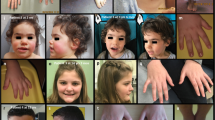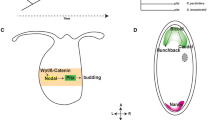Abstract
Ptx1 belongs to an expanding family of bicoid- related vertebrate homeobox genes. These genes, like their Drosophila homolog, seem to play a role in the development of anterior structures and, in particular, the brain and facies. We report the chromosomal localization of mouse Ptxl, and the cloning, sequencing, and chromosomal localization of the human homolog PTX1 The putative encoded proteins share 100% homology in the homeodomain and are 88% and 97% conserved in the N- and C-termini respectively. Intron/exon boundaries are also conserved. Murine Ptx1 was localized, by interspecific backcrossing, to Chr 13 within 2.6 cM of Caml. The gene resides centrally on Chromosome (Chr) 13 in a region syntenic with human Chr 5q. Subsequent analysis by fluorescent in situ hybridization places the human gene, PTX1, on 5q31, a region associated with Treacher Collins Franceschetti Syndrome. Taken together with the craniofacial expression pattern of Ptx1 during early development, the localization of the gene in this chromosomal area is consistent with an involvement in Treacher Collins Franceschetti Syndrome.
Similar content being viewed by others
References
Arn PH, Mankinen C, Jabs EW (1993) Mild mandibulofacial dysostosis in a child with a deletion of 3p. Am J Med Genet 46, 534–536
Avraham KB, Givol D, Avivi A, Yayon A, Copeland NG, Jenkins NA (1994) Mapping of murine fibroblast growth factor receptors refines regions of homology between mouse and human chromosomes. Genomics 21, 656–658
Boyle AL, Feltquite DM, Dracopoli NC, Housman DE, Ward DC (1992) Rapid physical mapping of cloned DNA on banded mouse chromosomes by fluorescence in situ hybridization. Genomics 12, 106–115
Copeland NG, Jenkins NA (1991) Development and applications of a molecular genetic linkage map of the mouse genome. Trends Genet 7, 113–118
Dixon J, Gladwin AJ, Loftus SK, Riley JH, Perveen R, Wasmuth JJ, Anand R, Dixon MJ (1994) A YAC contig encompassing the Treacher Collins syndrome critical region at 5q31.3-32. Am J Hum Genet 55, 372–378
Dixon MJ, Dixon J, Houseal T, Bhatt M, Ward DC, Klinger K, Landes GM (1993) Narrowing the position of the Treacher Collins syndrome locus to a small interval between three new microsatellite markers at 5q32-33.1. Am J Hum Genet 52, 907–914
Edery P, Manach Y, Le Merrer M, Till M, Vignal A, Lyonnet S, Munnich A (1994) Apparent genetic homogeneity of the Treacher Collins-Franceschetti syndrome. Am J Med Genet 52, 174–177
Fazen LE, Elmore J, Nadler HL (1967) Mandibulo-facial dysostosis. (Treacher-Collins syndrome). Am J Dis Child 113, 405–410
Gage PJ, Camper SA (1997) Pituitary homeobox 2, a novel member of the McoW-related family of homeobox genes, is a potential regulator of anterior structure formation. Hum Mol Genet 6, 457–464
Gladwin AJ, Dixon J, Loftus SK, Edwards S, Wasmuth JJ, Hennekam RCM, Dixon MJ (1997) Treacher Collins Syndrome may result from insertions, deletions or splicing mutations, which introduce a termination codon into the gene. Hum Mol Genet 5, 1533–1538
Green EL (1981) Linkage, Recombination and Mapping. (New York: Oxford University Press), pp 77–113
Heng HH, Tsui LC (1993) Modes of DAPI banding and simultaneous in situ hybridization. Chromosoma 102, 325–332
Hollander WF (1981) Linkage relations of dumpy, a recessive mutant on chromosome 13 of the mouse. J Hered 72, 358–359
Hunt PA, Smith DI (1955) Mandibulo-facial dysostosis. Pediatrics 15, 195–199
Jenkins NA, Copeland NG, Taylor BA, Lee BK (1982) Organization, distribution, and stability of endogenous ecotropic murine leukemia virus DNA sequences in chromosomes of Mus musculus. J Virol 43, 26–36
Lamonerie T, Tremblay JJ, Lanctôt C, Therrien M, Gauthier Y, Drouin J (1996) PTX1, a bicoid-related homeobox transcription factor involved in transcription of pro-opiomelanocortin (POMC) gene. Genes Dev 10, 1284–1295
Lanctôt C, Lamolet B, Drouin J (1997) The bicoid-related homeoprotein Ptx1 defines the most anterior domain of the embryo and differentiates posterior from anterior lateral mesoderm. Development 124, 2807–2817
Lichter P, Tang CJ, Call K, Hermanson G, Evans GA, Housman D, Ward DC (1990) High-resolution mapping of human chromosome 11 by in situ hybridization with cosmid clones. Science 247, 64–69
Mucchielli ML, Martinez S, Pattyn A, Goridis C, Brunet JF (1996) Otlx2, and Ott-related homeobox gene expressed in the pituitary gland and in a restricted pattern in the forebrain. Mol Cell Biol 8, 258–271
Rogers B (1964) Berry-Treacher Collins syndrome: a review of 200 cases. Br J Plast Surg 17, 109–136
Sänger F, Nicklen S, Coulson AR (1977) DNA sequencing with chain- terminating inhibitors. Proc Natl Acad Sci USA 74, 5463–5467
Semina EV, Reiter R, Leysens NJ, Alward WL, Small KW, Datson NA, Siegel-Bartelt J, Bierke-Nelson D, Bitoun P, Zabel BU, Carey JC, Murray JC (1996) Cloning and characterization of a novel bicoid-related homeobox transcription factor gene, RIEG, involved in Rieger syndrome. Nature Genet 14, 392–399
Szlazak J (1953) Treacher Collins syndrome. Can Med Assoc J 69, 274–276
Treacher Collins Syndrome Collaborative Group (1996) Positional cloning of a gene involved in the pathogenesis of Treacher Collins syndrome. Nature Genet 12, 130–136
Warren ST (1996) The expanding world of trinucleotide repeats. Science 271, 1374–1375
Winter RM (1996) What’s in a face? Nature Genet 12, 124–129
Wise CA, Chiang LC, Paznekas WA, Sharma M, Musy MM, Ashley JA, Lovett M, Jabs EW (1997) TCOF1 gene encodes a putative nucleolar phosphoprotein that exhibits mutations in Treacher Collins Syndrome throughout its coding region. Proc Natl Acad Sci USA 94, 3110–3115
Author information
Authors and Affiliations
Rights and permissions
About this article
Cite this article
Crawford, M.J., Lanctôt, C., Tremblay, J.J. et al. Human and murine PTX1/Ptx1 gene maps to the region for Treacher Collins Syndrome. Mammalian Genome 8, 841–845 (1997). https://doi.org/10.1007/s003359900589
Received:
Accepted:
Issue Date:
DOI: https://doi.org/10.1007/s003359900589




